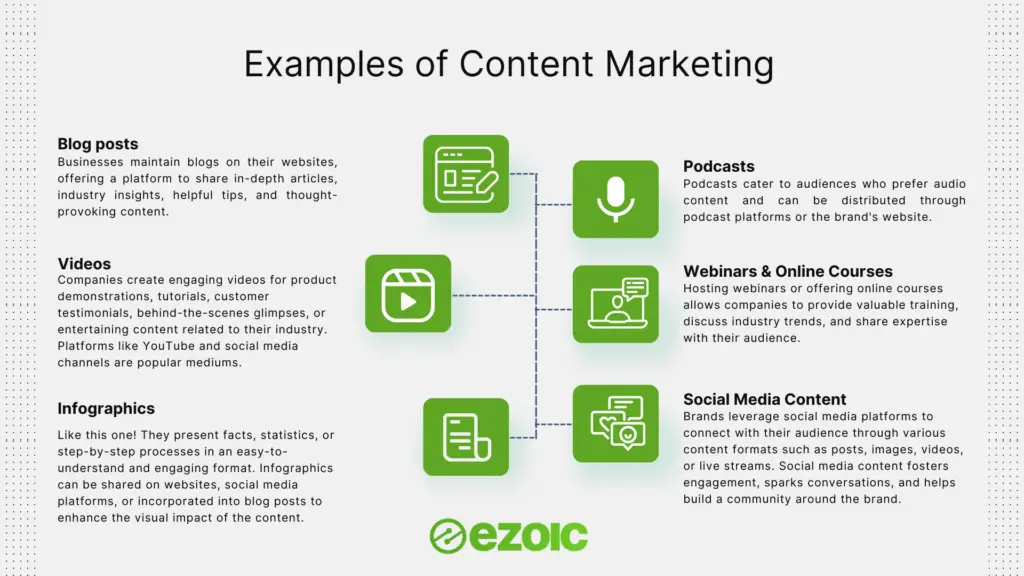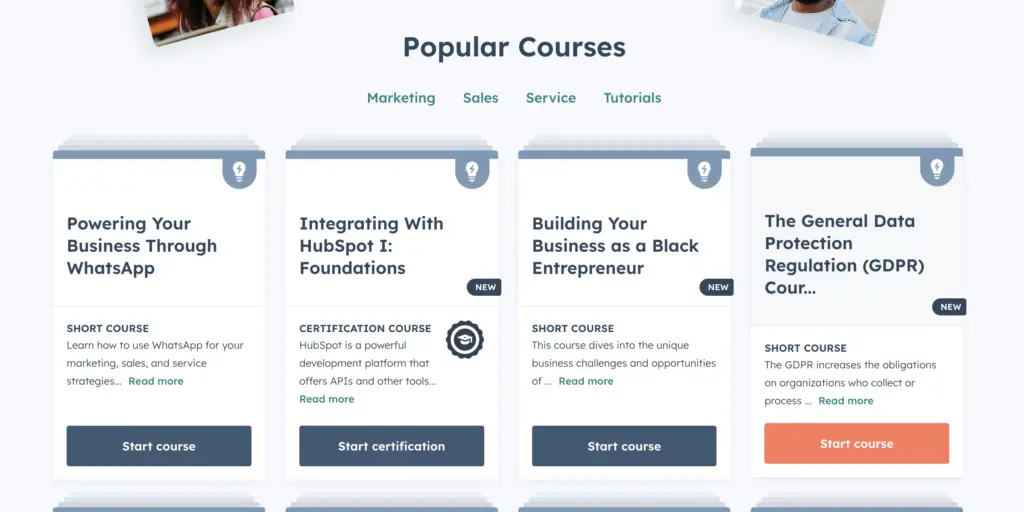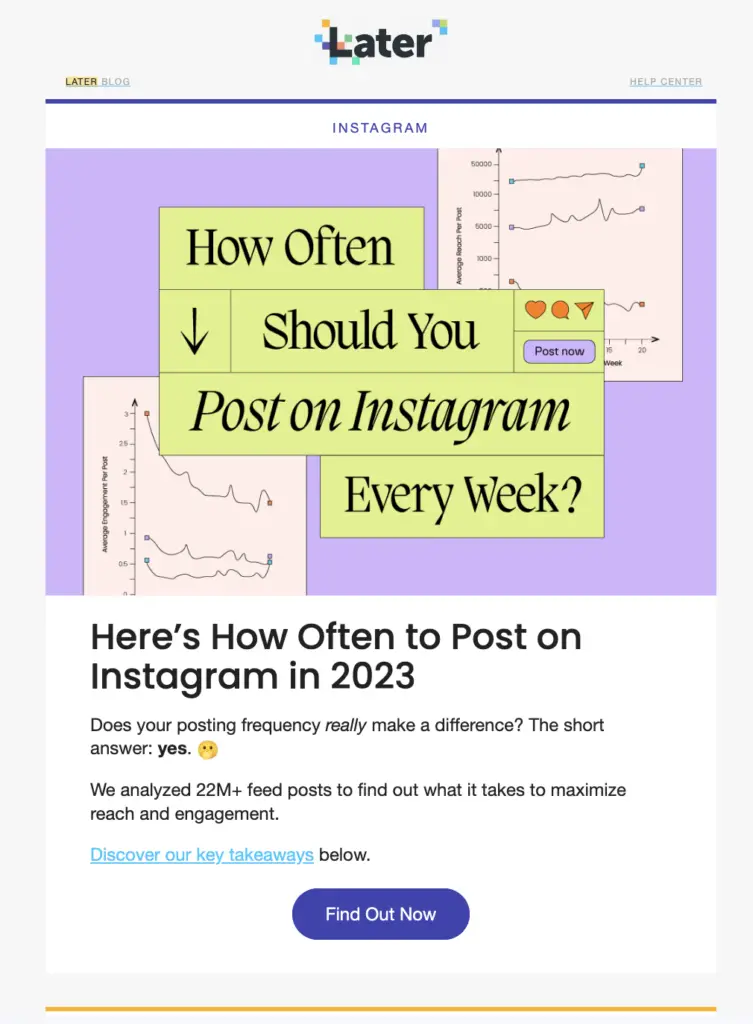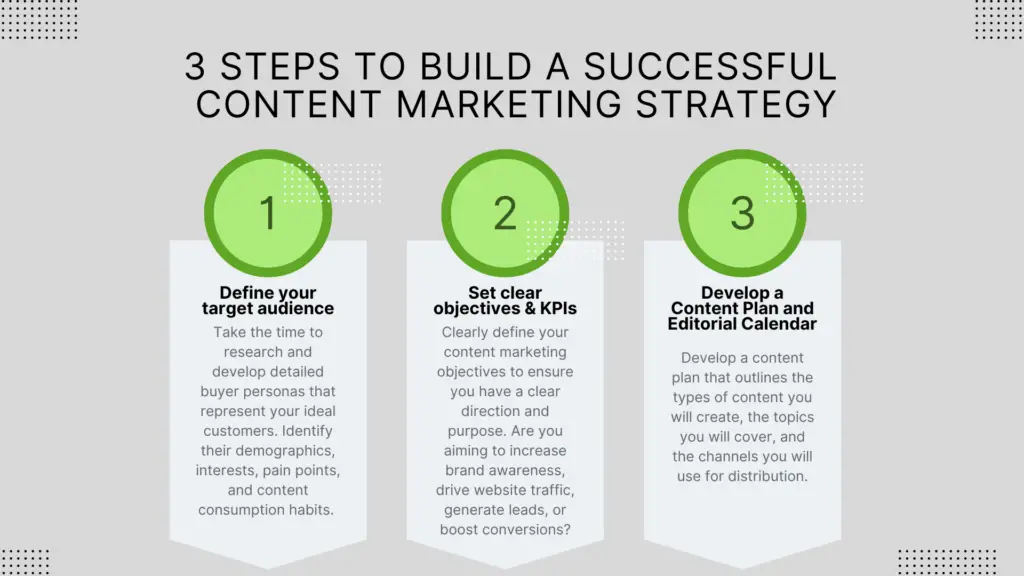
What is Content Marketing? 2023 Explanation with Examples

Get helpful updates in your inbox
If you’re someone in the digital marketing or content creation space, chances are you’ve heard of content marketing. It’s a prominent arm of most businesses and websites. In fact, 54% of businesses will increase their content marketing budgets this year.
But what is content marketing exactly? Content marketing is a giant blanket term that encompasses strategies from podcasts to blogs to YouTube videos and everything in between.
In this blog, I want to give you a one-stop-shop to understand all the basics you need to know about what content marketing is, why it is useful, how to execute on a good strategy and many examples of content marketing in practice. We’ll go over the following topics:
- What is content marketing?
- Traditional marketing vs. content marketing
- Examples of content marketing
- Building a content marketing strategy
What is content marketing?
If we want to zero in on a definition, we could go with this one:
Content marketing is a strategic way of marketing that focuses on creating and sharing valuable content to grab the attention and interest of a specific group of people. The goal is to build trust, show expertise, and make the brand more visible.
By understanding the audience, consistently producing good content, and promoting it on different platforms, content marketing aims to improve search results, bring more people to websites, and increase sales.
Essentially, content marketing is creating content that attracts people to your product or website rather than necessarily marketing the product itself. Any type of content that you create that informs your audience about topics relevant to them is likely an example of content marketing.
We’ll get into some more examples of content marketing throughout the blog, as well as some tips and best practices on executing them, but one way I thought would be helpful to explain what content marketing actually is is to break down Ezoic’s marketing strategy.
For our traditional marketing, we run ads and boosted posts on social media. We also run ads on Google AdWords, send out emails when we have product launches, put on events for customers complete with branded swag, and more. However, this blog, for example, is a main example of our content marketing. We write content that is not directly about our product, but that is relevant to our target audience (digital publishers) so that they might learn something, and eventually, think favorably about our brand.
We also produce a weekly podcast about current events in digital publishing with the same purpose. Hopefully this is starting to draw the distinction between traditional marketing and content marketing, but if not, read on!
Traditional marketing vs. content marketing
Traditional marketing refers to conventional forms of marketing that have been used for decades before the rise of digital and online platforms. It involves promoting products or services through various offline channels, such as television, radio, print media (newspapers, magazines), billboards, direct mail, and telemarketing. Traditional marketing focuses on reaching a broad audience and generating brand awareness through mass media.
Content marketing, on the other hand, is a marketing approach that revolves around creating and distributing valuable, relevant, and consistent content to attract and engage a specific target audience. It involves the creation of informative, entertaining, or educational content, such as blog posts, articles, videos, podcasts, infographics, and social media posts. The primary objective of content marketing is to provide value to the audience, build brand authority, and establish long-term relationships.
Here are some key differences between traditional marketing and content marketing:
Communication style
- Traditional marketing often relies on one-way communication, where the brand communicates its message to the audience without much interaction or engagement. Content marketing, on the other hand, encourages two-way communication, allowing for feedback, comments, and conversations with the audience.
Focus on promotion vs. providing value
- Traditional marketing primarily focuses on promoting products or services directly, often using persuasive techniques to encourage purchases. Content marketing focuses on providing valuable and relevant information to the audience, with the aim of building trust, establishing thought leadership, and indirectly influencing purchasing decisions.
Channel selection
- Traditional marketing utilizes offline channels such as TV, radio, print media, and billboards, whereas content marketing relies heavily on digital channels, including websites, blogs, social media platforms, and email newsletters.
Targeting
- Traditional marketing often targets a broad audience based on demographics, such as age, gender, and location. Content marketing emphasizes understanding the target audience’s interests, needs, and preferences, allowing for more personalized and targeted content.
Measurability
- Traditional marketing can be challenging to measure accurately in terms of its impact and return on investment (ROI). Content marketing, however, benefits from digital analytics and tracking tools that provide insights into content performance, audience engagement, conversion rates, and other key metrics.
Cost
- Traditional marketing campaigns can be quite expensive, especially when utilizing mass media platforms. Content marketing, while requiring time and effort for content creation, distribution, and promotion, can be relatively cost-effective, especially for smaller businesses or startups.
It’s important to note that traditional marketing and content marketing are not mutually exclusive. Many companies integrate both approaches to create a comprehensive marketing strategy that utilizes the strengths of each method to achieve their marketing objectives.
Examples of content marketing
Every website or brand may have a different approach that works for them when it comes to content marketing.

Blog Posts
- Businesses maintain blogs on their websites, offering a platform to share in-depth articles, industry insights, helpful tips, and thought-provoking content. Blog posts not only educate and entertain readers but also position the brand as an authority within its industry.
- An example I like of a brand that uses a blog to market themselves just by creating relevant content is Expedia. As a service that helps people to find deals on travel, a natural thing for them to do with content marketing is to create a travel blog. The key here to them having such great content is that they truly know their audience and know what they’re looking for. They also incorporate interesting statistics into their content that keeps users engaged. Overall, this is building their credibility as a go-to travel brand in the long term in a great way.

We offer countless resources on the Ezoic blog all about upkeep and content creation for successful blogs. For instance, you can check out 5 Ways to Cater Your Content to Your Audience to Increase Engagement, 4 Easy Ways to Scale Your Blog Content Output with ChatGPT or anything under our “Content Creation” topic.
Videos
In the age of visual storytelling, videos have become a powerful content marketing tool. Companies create engaging videos for product demonstrations, tutorials, customer testimonials, behind-the-scenes glimpses, or entertaining content related to their industry. Platforms like YouTube and social media channels are popular mediums for video content distribution.
A great example of a brand that creates video content relevant to their brand is Red Bull. Red Bull is obviously an energy drink, but they create a lot of content around their central message of “Red Bull gives you wings” to pitch Red Bull as a lifestyle that makes you adventurous and exciting. The content in itself is something that users would want to watch on its own, which is an important lesson to content marketing: it must have inherent value and not be overly promotional, or else users will see through it and not be interested in it.
Here’s an example of a video by Red Bull pulled from their YouTube channel, which has 11.6M subscribers, by the way.
Infographics
Infographics are visually appealing representations of complex information or data. They present facts, statistics, or step-by-step processes in an easy-to-understand and engaging format. Infographics can be shared on websites, social media platforms, or incorporated into blog posts to enhance the visual impact of the content.
Social Media Content
Brands leverage social media platforms to connect with their audience through various content formats such as posts, images, videos, or live streams. Social media content fosters engagement, sparks conversations, and helps build a community around the brand.
I think it’s easy for all of us to market our content on social media, but what makes social media content marketing? Anything that is adding value and interesting your customers on its own is doing the job. Think to yourself about brands that you choose to follow on social media – what are they providing? Why do you like to follow them?
An example here: Countless recipe videos. I love viewing how creative TikTokers, YouTubers and recipe pages get with sharing their culinary creations. Below are a few examples of pages doing a great job of this.
For more tips about being a great social media marketer, you can check out this recent Ezoic blog all about picking the right social platform for you.
Podcasts
Podcasts have gained significant popularity as a content marketing format. Brands create their podcasts to share industry insights, interview experts, tell stories, or provide educational content. Podcasts cater to audiences who prefer audio content and can be distributed through podcast platforms or the brand’s website.
An example of a podcast that is doing great content marketing is REI. REI’s podcast, Wild Ideas Worth Living, has the following description on Apple Podcasts:
“High-impact interviews for those who love adventure and the outdoors. Host and journalist Shelby Stanger interviews world-class explorers, athletes, authors, scientists, health experts and entrepreneurs about how they’ve taken their own wild ideas and made them a reality, so you can too. Some of the wildest ideas can lead to the most rewarding adventures.“

Webinars and Online Courses
Hosting webinars or offering online courses allows companies to provide valuable training, discuss industry trends, and share expertise with their audience. These interactive sessions engage participants, provide opportunities for real-time interaction, and position the brand as a go-to resource.
One example that comes to mind here is Hubspot and how they offer courses for email marketing certifications and other important topics in marketing. These courses are free, although behind a signup page, but put Hubspot at the top of your mind in terms of relevance and make you trust them as somewhere to help you with your marketing needs.

Newsletters
Although newsletters can be examples of traditional marketing, some newsletters act as content marketing, too. Many brands work on establishing a newsletter that serves as a resource for industry news or tips. Over time, these helpful tidbits of information increase your trust in the brand and encourage you to keep coming back for more information. These newsletters typically are visual-rich and link out to blogs made by the sender’s own brand or other relevant content.
One great example of this is Later and its weekly social media newsletter. It includes valuable social media tips each week that social media marketers like myself really value learning about, and it sends these out for free. Each newsletter does a great job at painting Later as a huge authority on social media and the latest trends in what’s going on.

One thing you may not have thought of doing yet is using AI to help you with your content marketing. For instance, we have a whole blog all about using ChatGPT for email. There are countless ways to employ the tool to make your life easier.
These above examples of content marketing highlight the diversity and versatility of all the strategies there are available to you. By leveraging these approaches, businesses can effectively connect with their target audience, provide value, and build long-lasting relationships.
Building a content marketing strategy
Building an effective content marketing strategy requires careful planning and consideration. Here are three essential tips to help you develop a strong content marketing strategy:

- Define Your Target Audience: The foundation of a successful content marketing strategy lies in understanding your target audience. Take the time to research and develop detailed buyer personas that represent your ideal customers. Identify their demographics, interests, pain points, and content consumption habits. This information will guide you in creating content that resonates with your audience and addresses their specific needs. Tailoring your content to your target audience will increase engagement and attract the right kind of traffic to your brand.
- Set Clear Objectives and KPIs: Clearly define your content marketing objectives to ensure you have a clear direction and purpose. Are you aiming to increase brand awareness, drive website traffic, generate leads, or boost conversions? Establishing specific and measurable goals will help you track your progress and evaluate the success of your content marketing efforts. Additionally, identify key performance indicators (KPIs) that align with your objectives, such as page views, social media engagement, email subscribers, or conversion rates. Regularly monitor these metrics to measure the impact of your content and make data-driven adjustments as needed.
- Develop a Content Plan and Editorial Calendar: Creating valuable content consistently is crucial for building a successful content marketing strategy. Develop a content plan that outlines the types of content you will create, the topics you will cover, and the channels you will use for distribution. Consider the formats that resonate best with your audience, such as blog posts, videos, or infographics. Furthermore, establish an editorial calendar to organize your content creation and publication schedule. This calendar will help you maintain consistency, manage deadlines, and ensure a steady flow of content. It also allows you to align your content with important events, holidays, or industry trends.
Remember to regularly evaluate and refine your content marketing strategy based on data, feedback, and evolving audience needs. By consistently providing valuable and relevant content that addresses your target audience’s pain points, interests, and preferences, you can establish your brand as a trusted authority, drive engagement, and ultimately achieve your marketing goals.
Wrapping it all up: What is content marketing?
In conclusion, content marketing is a powerful strategy that allows businesses to engage their audience, build trust, and drive customer action. By creating valuable content, understanding your target audience, setting clear objectives, and planning consistently, you can establish your brand as an industry leader and achieve marketing success. Embrace the diverse examples of content marketing and continuously refine your strategy to stay relevant in the digital landscape.

Linden is a former journalism graduate of the University of Missouri turned social media and content marketer. She speaks fluent English, Spanish, and French and is responsible for Ezoic social marketing strategies.
Featured Content
Checkout this popular and trending content

Ranking In Universal Search Results: Video Is The Secret
See how Flickify can become the ultimate SEO hack for sites missing out on rankings because of a lack of video.
Announcement

Ezoic Edge: The Fastest Way To Load Pages. Period.
Ezoic announces an industry-first edge content delivery network for websites and creators; bringing the fastest pages on the web to Ezoic publishers.
Launch

Ezoic Unveils New Enterprise Program: Empowering Creators to Scale and Succeed
Ezoic recently announced a higher level designed for publishers that have reached that ultimate stage of growth. See what it means for Ezoic users.
Announcement
